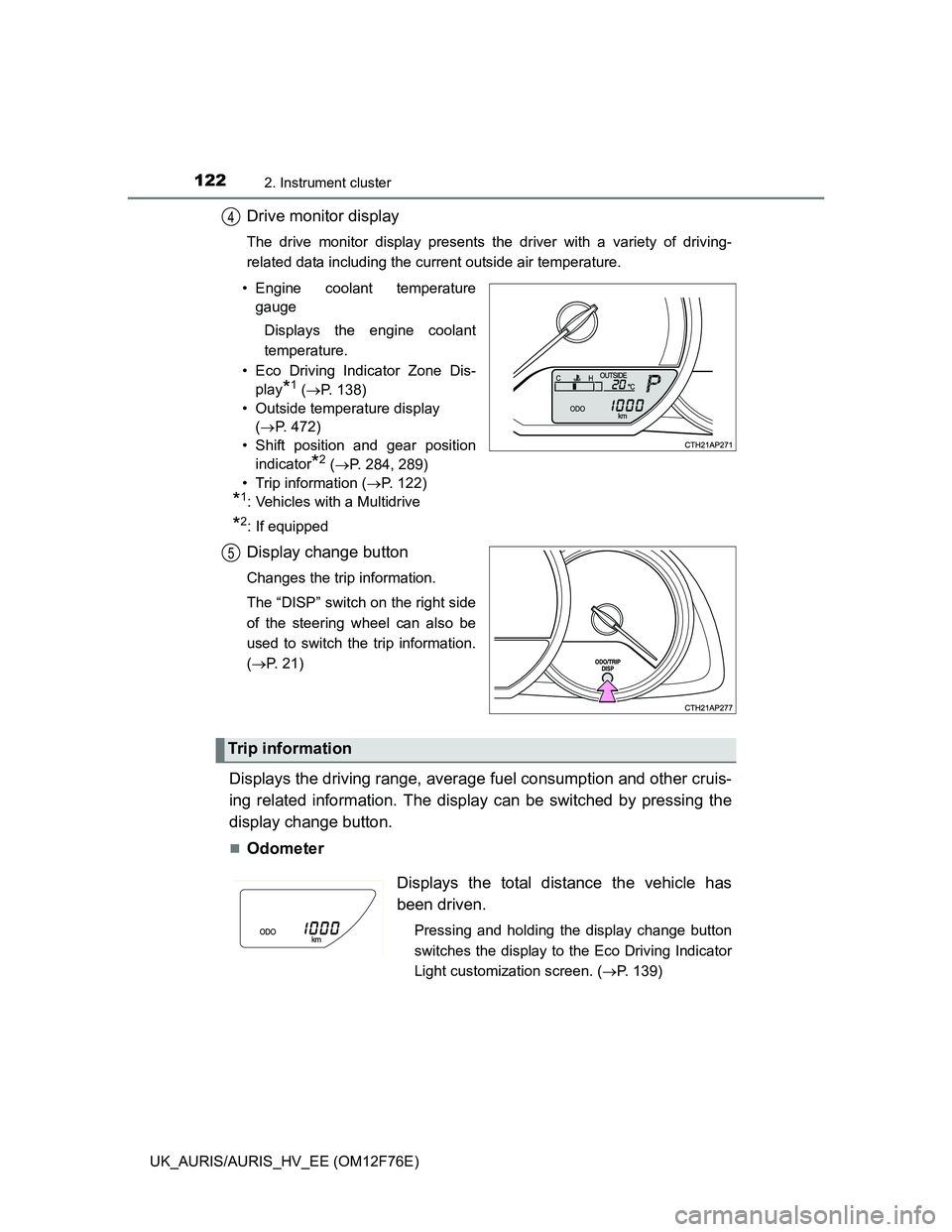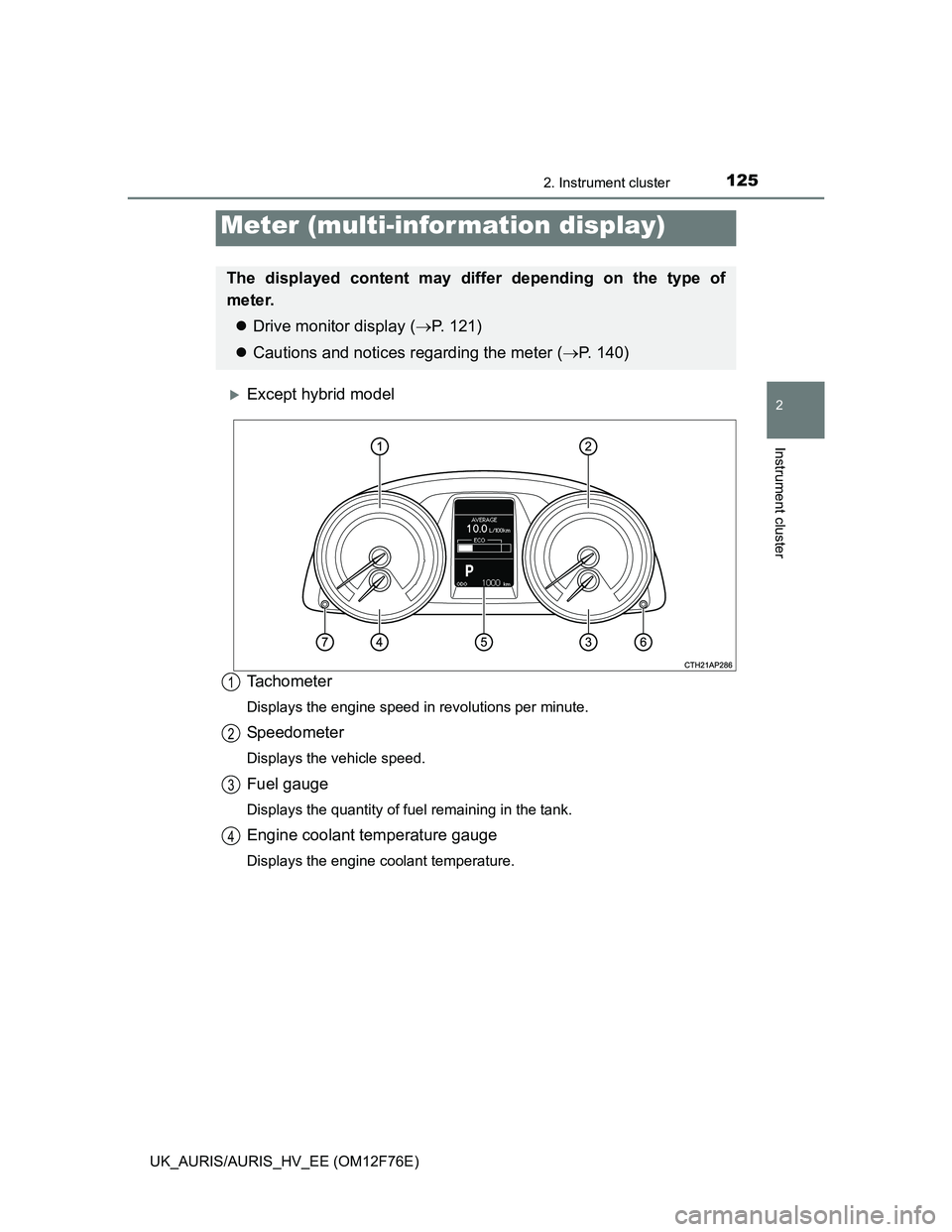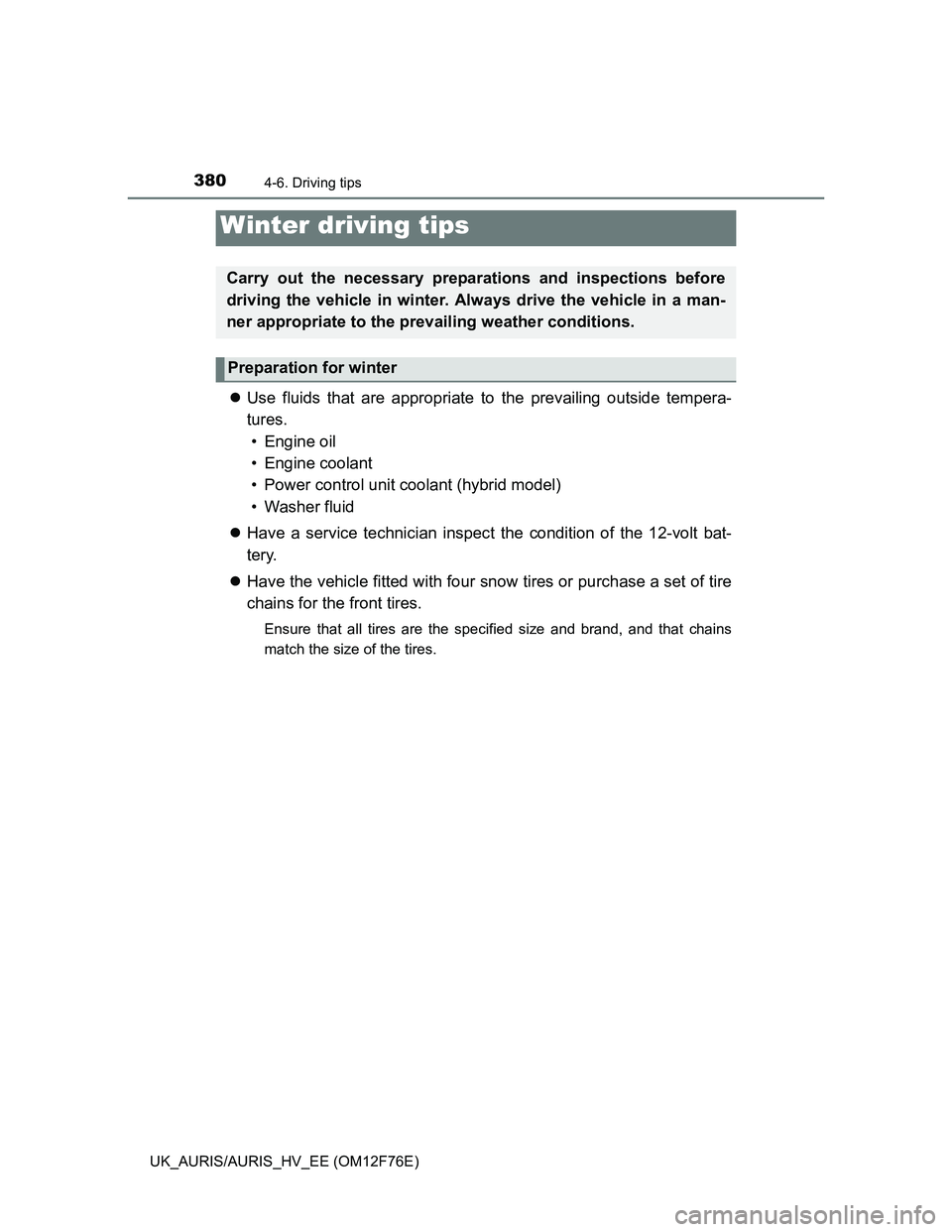2013 TOYOTA AURIS HYBRID engine coolant
[x] Cancel search: engine coolantPage 116 of 768

1162. Instrument cluster
UK_AURIS/AURIS_HV_EE (OM12F76E)
Warning lights inform the driver of malfunctions in the indicated vehi-
cle’s systems.
Warning lights
*1, 2
(Red)
Brake system warning
light (P. 597)*1, 2Electric power steering
system warning light
(P. 600)
*2
(Yellow)
Brake system warning
light (hybrid model)
(P. 601)*4, 7
(Yellow)
Automatic High Beam
indicator light (P. 601)
*1, 3
Charging system warn-
ing light (P. 598)*4, 7
(Yellow)
Cruise control indicator
light (P. 601)
*1, 3
Low engine oil pressure
warning light (P. 598)*4, 7
(Yellow)
Speed limiter indicator
light (P. 601)
*1, 3High engine coolant
temperature warning
light (P. 598)*4, 5Stop & Start cancel indi-
cator (P. 600)
*1Multi-mode manual
transmission warning
light (vehicles with a
multi-mode manual
transmission) (P. 598)*4, 6
(Yellow)
Smart entry & start sys-
tem indicator light
(P. 601)
*1, 2Malfunction indicator
lamp (P. 600)*1, 3Fuel filter warning light
(diesel engine)
(P. 601)
*1, 2SRS warning light
(P. 600)*3Open door warning light
(P. 602)
*1, 2ABS warning light
(P. 600)Low fuel level warning
light (P. 602)
Page 122 of 768

1222. Instrument cluster
UK_AURIS/AURIS_HV_EE (OM12F76E)
Drive monitor display
The drive monitor display presents the driver with a variety of driving-
related data including the current outside air temperature.
• Engine coolant temperature
gauge
Displays the engine coolant
temperature.
• Eco Driving Indicator Zone Dis-
play
*1 (P. 138)
• Outside temperature display
(P. 472)
• Shift position and gear position
indicator
*2 (P. 284, 289)
• Trip information (P. 122)
*1: Vehicles with a Multidrive
*2: If equipped
Display change button
Changes the trip information.
The “DISP” switch on the right side
of the steering wheel can also be
used to switch the trip information.
(P. 21)
Displays the driving range, average fuel consumption and other cruis-
ing related information. The display can be switched by pressing the
display change button.
Odometer
4
5
Trip information
Displays the total distance the vehicle has
been driven.
Pressing and holding the display change button
switches the display to the Eco Driving Indicator
Light customization screen. (P. 139)
Page 125 of 768

1252. Instrument cluster
UK_AURIS/AURIS_HV_EE (OM12F76E)
2
Instrument cluster
Except hybrid model
Tachometer
Displays the engine speed in revolutions per minute.
Speedometer
Displays the vehicle speed.
Fuel gauge
Displays the quantity of fuel remaining in the tank.
Engine coolant temperature gauge
Displays the engine coolant temperature.
Meter (multi-infor mation display)
The displayed content may differ depending on the type of
meter.
Drive monitor display (P. 121)
Cautions and notices regarding the meter (P. 140)
1
2
3
4
Page 140 of 768

1402. Instrument cluster
UK_AURIS/AURIS_HV_EE (OM12F76E)
CAUTION
The display at low temperatures
Allow the interior of the vehicle to warm up before using the display. At
extremely low temperatures, the display monitor may respond slowly, and
display changes may be delayed.
For example, there is a lag between the driver’s shifting and the new gear
number appearing on the display. This lag could cause the driver to down-
shift again, causing rapid and excessive engine braking and possibly an
accident resulting in death or injury.
Cautions during setting up the display
As the engine needs to be running during setting up the display, ensure that
the vehicle is parked in a place with adequate ventilation. In a closed area
such as a garage, exhaust gases including harmful carbon monoxide (CO)
may collect and enter the vehicle. This may lead to death or a serious
health hazard.
NOTICE
To prevent damage to the engine and its components
Do not let the indicator needle of the tachometer enter the red zone, which
indicates the maximum engine speed.
The engine may be overheating in the following situations. Immediately
stop the vehicle in a safe place, and check the engine after it has cooled
down completely. (P. 700, 703)
Drive monitor display: When the high engine coolant temperature warning
light comes on.
Multi-information display: When the indicator needle of the engine coolant
temperature gauge enters the red zone (except hybrid model), or the
engine coolant temperature warning message is shown on the multi-infor-
mation display (hybrid model).
Page 250 of 768

2504-1. Before driving
UK_AURIS/AURIS_HV_EE (OM12F76E)
Important points regarding stability
Vehicle movement resulting from uneven road surfaces and strong
crosswinds will affect handling. The vehicle may also be rocked by
passing buses or large trucks. Frequently check behind when mov-
ing alongside such vehicles. As soon as such vehicle movement
occurs, immediately start to decelerate smoothly by slowly applying
the brakes. Always steer the vehicle straight ahead while braking.
Passing other vehicles
Consider the total combined length of your vehicle and trailer and
ensure that the vehicle-to-vehicle distance is sufficient before exe-
cuting lane changes.
Transmission information
Multidrive:
To maintain engine braking efficiency and charging system perfor-
mance when using engine braking, do not use the transmission in
D, must be in M and select gear step 4 or lower. (P. 287)
Multi-mode manual transmission:
Select an appropriate gear in M position to maintain the effective-
ness of engine braking and to maintain charging system perfor-
mance.
Manual transmission:
Refrain from driving in 6th gear to maintain the effectiveness of
engine braking and to maintain charging system performance.
If the engine overheats
Towing a loaded trailer up a long, steep incline in temperatures
exceeding 30C (85F) may result in the engine overheating. If the
engine coolant temperature gauge indicates that the engine is over-
heating, turn the air conditioning off immediately, leave the road and
stop the vehicle in a safe place. (P. 700)
Page 260 of 768

2604-1. Before driving
UK_AURIS/AURIS_HV_EE (OM12F76E)
Sudden acceleration/steering input/cornering
Executing sharp turns when towing may result in the trailer colliding
with your vehicle. Decelerate well in advance when approaching
turns and take them slowly and carefully to avoid sudden braking.
Important points regarding turning
The wheels of the trailer will travel closer to the inside of the curve
than the wheels of the vehicle. To make allowance for this, take the
turns wider than you would normally do.
Important points regarding stability
Vehicle movement resulting from uneven road surfaces and strong
crosswinds will affect handling. The vehicle may also be rocked by
passing buses or large trucks. Frequently check behind when mov-
ing alongside such vehicles. As soon as such vehicle movement
occurs, immediately start to decelerate smoothly by slowly applying
the brakes. Always steer the vehicle straight ahead while braking.
Passing other vehicles
Consider the total combined length of your vehicle and trailer and
ensure that the vehicle-to-vehicle distance is sufficient before exe-
cuting lane changes.
Transmission information
To maintain engine braking efficiency and charging system perfor-
mance when using engine braking, do not use the transmission in
D. Shift the shift position to B.
If the engine overheats
Towing a loaded trailer up a long, steep incline in temperatures
exceeding 30C (85F) may result in the engine overheating. If the
engine coolant temperature gauge indicates that the engine is over-
heating, turn the air conditioning off immediately, leave the road and
stop the vehicle in a safe place. (P. 680)
When parking the vehicle
Always place wheel chocks under the wheels of both the vehicle
and trailer. Firmly set the parking brake and shift the shift position to
P.
Page 364 of 768

3644-5. Using the driving support systems
UK_AURIS/AURIS_HV_EE (OM12F76E)
Operating conditions
The Stop & Start system is operational when all of the following conditions
are met:
• The engine is adequately warmed up.
• The 12-volt battery is sufficiently charged.
• The driver's door is closed.
• The driver's seat belt is fastened.
• The hood is closed.
• The clutch pedal is not being depressed.
• The shift lever is in N.
In the following circumstances the engine may not be stopped by the Stop &
Start system. This is not a malfunction of the Stop & Start system.
• Engine coolant temperature is too low or too high.
• Diesel engine: The outside temperature is too low.
• Vehicles with an automatic air conditioning system: The air conditioning
system is being used when the vehicle interior temperature is extremely
high such as after the vehicle was parked under the hot sun.
• Vehicles with an automatic air conditioning system only: The windshield
defogger is being used.
• Vehicles with a power heater: The power heater is being used.
• The 12-volt battery is not sufficiently charged, or is undergoing a peri-
odic recharge.
• Due to traffic or other circumstances the vehicle is stopped repeatedly,
resulting in the amount of time the engine is stopped by the Stop & Start
system to become excessively high.
• The brake booster vacuum is low.
• A large amount of electricity is being used.
• At high altitude
When the above conditions improve, the Stop & Start system will stop and
restart the engine from the next time the vehicle is stopped.
In the following situations, it may take longer than normal for the Stop & Start
system to activate.
• The 12-volt battery is discharged.
• After the 12-volt battery terminals have been disconnected and recon-
nected after a 12-volt battery replacement, etc.
• The engine coolant temperature is low.
Page 380 of 768

3804-6. Driving tips
UK_AURIS/AURIS_HV_EE (OM12F76E)
Use fluids that are appropriate to the prevailing outside tempera-
tures.
• Engine oil
• Engine coolant
• Power control unit coolant (hybrid model)
• Washer fluid
Have a service technician inspect the condition of the 12-volt bat-
tery.
Have the vehicle fitted with four snow tires or purchase a set of tire
chains for the front tires.
Ensure that all tires are the specified size and brand, and that chains
match the size of the tires.
Winter driving tips
Carry out the necessary preparations and inspections before
driving the vehicle in winter. Always drive the vehicle in a man-
ner appropriate to the prevailing weather conditions.
Preparation for winter